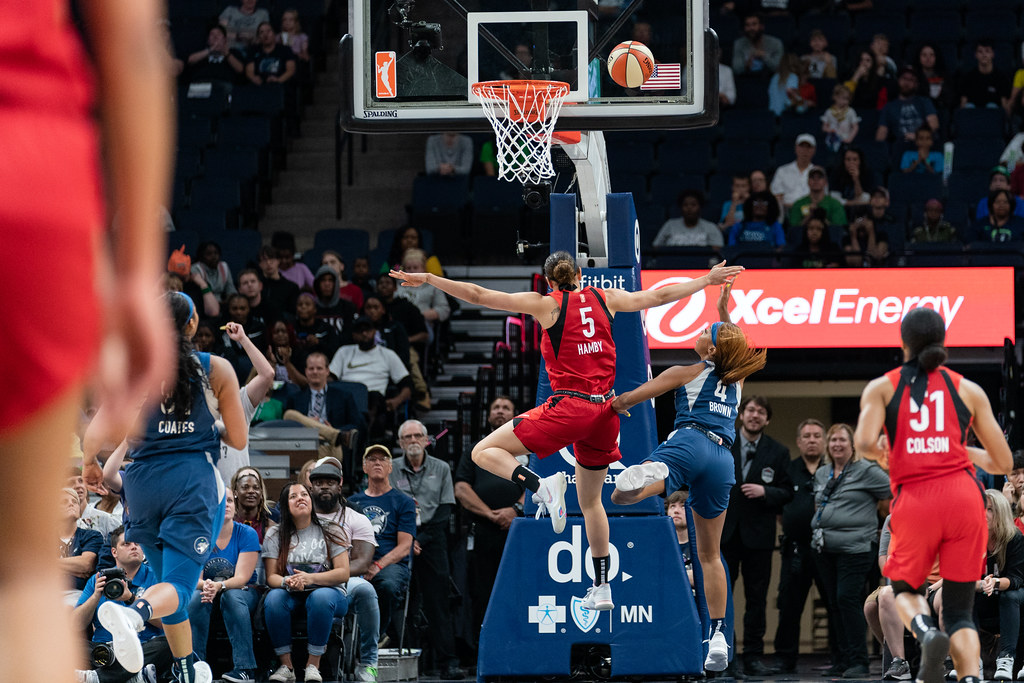
The recent surge in the WNBA’s popularity has had a side effect I didn’t anticipate: all this discussion about women’s bodies. It might seem a strange thing to be surprised by but, confusingly, in sports, athletes’ bodies often seem secondary to the actions they execute.
There’s been such a sense of shock from new viewers over the sight of women’s bodies in the midst of their regular, professional routines. They run and jump and, as a result, sometimes collide. They are just bodies at work, but they are described using words like “assault” and “attack” (this from an Indiana congressman). There is a discomfort, it seems, in seeing women’s bodies moving without restraint.
Sports discourse has always existed in the context of its biases. These can be relatively innocent, like rooting interest and recency bias creeping into game coverage, or they can veer into more noxious territory, like athletes in predominantly Black leagues being referred to as thugs. Despite this, men’s professional sports are still seen by a majority of fans as existing outside the biases that inform it—a haven removed from the real world, a place of escape. “Sticking to sports” is still a golden rule for many major sports news desks.
What I’ve noticed while watching many new fans flock to the W is that these biases are anything but subtle when they spark from women’s basketball. Women’s sports—perhaps just women’s bodies—act as a mirror, revealing prejudice in perfect, obvious detail.
Take, for example, complaints that the game this year has been too physical (note here that most people making this complaint did not watch other seasons with which they can compare it), that veteran athletes are targeting rookies, targeting one rookie in particular. Beyond the racial overtones in this critique of undue physicality, leveled only at Black athletes, the underlying discomfort seems to be with women competing in a contact sport. In fact, viewers are objecting not to excessive physicality, not even to overt physicality, but simply to physical contact.
Women’s bodies have long been ceded to the public as objects of discourse, whose merits and deficiencies should be freely discussed by all. Historically, the WNBA’s mainstream coverage has been no different. Bill Simmons once critiqued the W for its lack of sex appeal. “The vast majority of WNBA players lack crossover sex appeal…” he writes. “Some are uncomfortably tall and gawky, while others lack the requisite, um, softer qualities to captivate males between eighteen and thirty-five. The baggy uniforms don’t help.”
But at least, in the past, the athletes, beat writers, and fans of the WNBA didn’t often discuss bodies at all, they talked about basketball. In recent weeks, there’s been so much written and said about the bodies of these W players—what they can and should do, and which ones can and should do it—but so little of the coverage from major outlets has been about the games. The floor in action and the bodies luxuriating on it, hard fouls and all. The barely veiled misogyny that questions whether these trained professionals know how to do their job extends into a bizarre hysteria that, at its most extreme conclusion, seems to want W athletes to play without touching.
It’s been on that note that I’ve been dwelling. And, as a reprieve, I’ve been focusing on the minutiae of these bodies at work—watching game footage, zeroing in on specific moves and sequences of action, drawing out three seconds of an athlete’s muscular chronology, physical habits that turn second-nature into style. Like the Phoenix Mercury’s Brittney Griner, a 6’9” center who tends to hunker down in the paint. Griner is one of the most physically imposing players in the league, as strong as she is fluid. One second, she’s using her long stride to skate over the floor, out to a teammate in need of a screen, and the next she has morphed into a wall, unyielding, catching a defender on her hip so her teammate can slip by and take the shot.
The Lynx’s Napheesa Collier, with her timing and soft touch, can look leisurely in her offensive drives. In spins that shift her off the bodies of defenders, she moves like water taking the most sloping path. Even during her more hurried moments, when she’s sprinting to shake defenders, getting clear for an inbound pass, Collier is patient, waiting for the right second to feint a step and rush, free, the other way.
Los Angeles Sparks teammates Dearica Hamby and Lexie Brown play like they’re sling-shooting each other out into orbit. In a sequence from earlier this season, when the Sparks were down to the Mystics and in need of some offensive gas, Brown sprints the ball back in transition and explodes as she hits center court, speeding into another gear. Down the floor, Hamby has been watching, syncing her sprint to speed up at the same time as Brown, so she can break free from her now trailing defender. Hamby raises her right arm, running with it up to signal for the pass, and, without pausing, Brown launches the ball to Hamby, who catches the ball like she had beckoned it. Hamby briefly palms it between both her hands before pogoing up, now under the rim, to make the basket. The whole sequence takes less than five seconds but the conversation between the two, the fluidity and velocity of their bodies at work, took years to master.
Aliyah Boston, with her one-arm, one-leg finishes; her sheer strength can look balletic. DeWanna Bonner’s three-pointers, especially when she steps into them lightly, arching like arrows from her hands to the basket. Alyssa Thomas, nicknamed “The Engine” for her locomotive force, running down the middle of the paint without slowing to deliver a layup. Kahleah Copper, lithe, somewhat frenetic, and tough as she drives, swings, and finishes through a tangle of bigger bodies, all trying desperately to hang on to her.
The elements I love most about basketball are grounded in the bare physical nature of the sport: forced air, its sound shaped from a mouth, after a particularly powerful dunk or a devastating chase-down block; sneaker squeaks on hardwood; the expressions of strain-to-triumph in a tricky sequence. These are bodies with hardly any protective equipment, save the occasional mouthguard or tension bandage, as bare to our eyes as they are to their competitors in the crunch, the flush of straining action. There is competitive contact, which in one league is considered good, is easily appreciated, and in another is not. But there is no basketball without the bodies powering it. These bodies are the markers and makers of the same game, so why not be thankful for them? For witnessing them perform greatness so easily and so often. Physicality as emphasis, as conduit, as gift.





